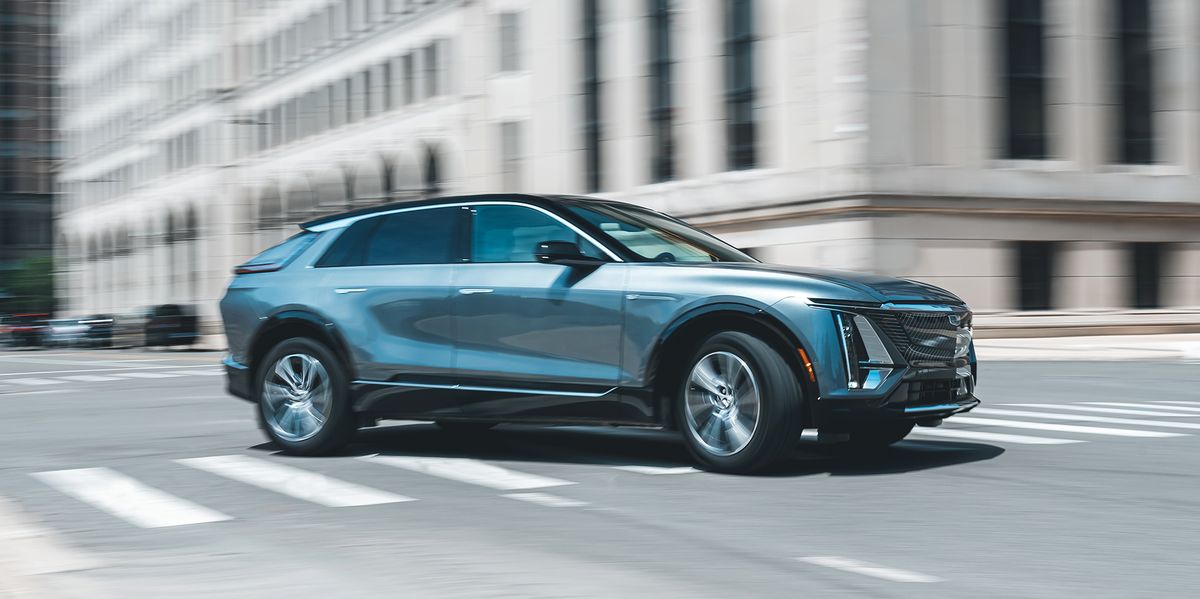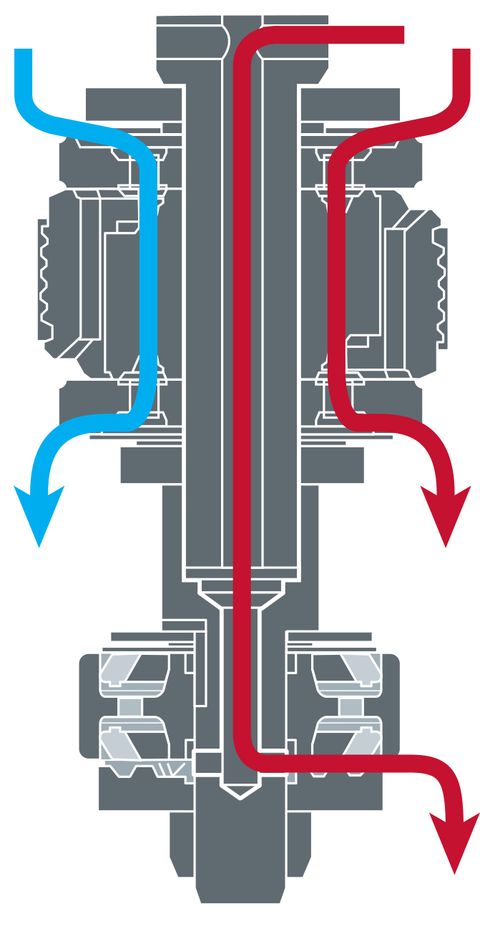Tested: 2023 Cadillac Lyriq 450E Debut Edition

From the September 2022 issue of Car and Driver.
Whoosh goes the Cadillac. And then it glides. Drive the all-electric Lyriq and you’re reminded of the quiet grace of Cadillacs past. Electrification appears to be returning the 120-year-old brand to its smooth, silent, and comfortable roots. In reaching for the future—Cadillac promises an all-EV lineup by 2030—the luxury carmaker is reintroducing a few long-dismissed attributes.
The Lyriq’s demeanor is in keeping with the virtues of its powertrain. An electric motor, such as the permanent-magnet spinner in the Lyriq (340 horsepower and 325 pound-feet of torque), never does much more than hum. The 102.0-kWh battery pack in the floor—sort of like sitting atop a giant slice of Texas toast—suppresses nearly all road noise. A wind-cheating and range-extending shape helps keep the air’s howl to a low whisper at highway speed. The direct-drive transmission provides uninterrupted thrust. Sail on, 5642-pound Lyriq.
Marc UrbanoCar and Driver
Fortunately, the suspension tuning doesn’t venture too far back into history. Ride quality sticks to the comfort side of the ride-handling spectrum, but it’s free of any floatiness. Some initial impact harshness is quickly forgotten as the multilink front and rear suspension gently stroke away the ripples. Steering isn’t as light as the roulette wheels in old Coupe DeVilles, but no one who wants a Blackwing will find much to love about the Lyriq’s handling. Competency won out over playfulness, and all-season rubber, size 265/50R-20, summons a mere 0.80 g on the skidpad. The battery keeps the center of gravity low, and weight distribution is 48.7 percent front and 51.3 percent rear, which may say “sports sedan” balance, but the mass wins out over the tires. The testing team did report that with stability and traction control disabled, our rear-drive Lyriq will do some mighty fine drifts on the skidpad, should you want to pretend you’re on staff here.
HIGHS: Silence is golden, practical range, a relative value.
Marc UrbanoCar and Driver
If you’re inclined to continue to drive like our testers, you’ll find that the rear-drive Lyriq’s 5.7-second time to 60 won’t leave much of a mark on your memory or back. A sub-six-second 60-mph time isn’t slow, but in a world where the Genesis GV60 hits 60 in 3.7 seconds and like-priced EVs are reliably under five seconds, the Lyriq lacks the ferocious acceleration we’re coming to expect as a given in EVs. Perhaps to keep things calm, Cadillac doesn’t feed in full power until speeds are north of 40 mph. A quicker version with a second motor and 500 horsepower is on its way for those seeking more thrills. Stopping from 70 takes a long 191 feet; one-pedal driving is possible for those who enjoy not having to use the brake pedal.
On the highway at a steady 75 mph, the Lyriq returns 270 miles of range, which isn’t far off its 312-mile EPA estimate. A 19.2-kW onboard charger can restore a depleted battery in about six hours if you have a Level 2 connection capable of delivering that much juice. DC fast-charging can swallow up to 190 kilowatts and add up to 195 miles of range in 30 minutes. Like in the GMC Hummer EV, GM’s Ultium battery motivates the machine. Made up of pouch-type lithium-ion cells that each weigh about three pounds and hold just under 0.4 kilowatt-hour of energy, the 288-cell battery delivers a 102.0-kWh usable capacity.
Marc UrbanoCar and Driver
LOWS: Not quick for an EV, long braking distances, competence instead of fun, no frunk.
The Lyriq rides on a long 121.8-inch wheelbase, and the cabin is airy, although the giant glass roof does seem like a bad idea in the summer or in sunny parts of the world. In the front, two white leather seats (vented and heated) provide easy adjustment and face a swept-back windshield. A large storage track between the footwells is the perfect place for a small bag, and a drawer that would’ve been an ashtray in the last century is instead leather lined and ready for a phone or other stuff.
Aside from a few obviously plastic bits, interior materials look and feel rich. The laser-cut wood inlays on the doors are particularly attractive. A large, sweeping 33-inch panel houses a configurable speed and power display behind the steering wheel, as well as an infotainment touchscreen to the right of the gauges. The HVAC controls have hard buttons, but the touchscreen hides a number of controls and settings. Before Cadillac updated its software to simplify the procedure, opening the glovebox on our pre-production Lyriq required multiple screen taps, which could make getting pulled over even more annoying.
Marc UrbanoCar and Driver
VERDICT: Cadillac’s future draws from its past.
If you think that’s a bad idea, wait until you open the doors from the outside. What appears to be a door handle is merely a switch that cracks the door open. From there, it’s up to you to grab the tab at the base of the window to swing the door fully open—and the rear doors don’t even have a tab to grab. What used to be one step—pull—is now two. Ah, the future.
Other missteps include the lack of storage under the hood. Cargo space behind the rear seat measures 28 cubic feet; folding the seat increases that to 61 cubic feet. But a purpose-built EV without a frunk strikes us as a miss. (Peek under the plastic cover and you’ll find some wasted space.) All-wheel-drive versions will place a motor up there.
At first glance, we thought the Lyriq’s price might be a mistake. Cadillac is selling the lavishly equipped rear-drive version for $62,990. That’s a mere $6000 more than the far less luxurious, but quicker, Hyundai Ioniq 5 in our EV competition. Aggressive pricing may explain why Cadillac has sold out Lyriq production for 2023. The Lyriq won’t ever be mistaken for a Blackwing, but its refinement is in keeping with the cars that made Cadillac famous.
Marc UrbanoCar and Driver
Counterpoints
The Lyriq reminds me of my grandfather’s old 1984 Seville—hushed, smooth, not quick. West Palm Beach with wheels. Click on Super Cruise and go eat up some miles. Crank some yacht rock on the 19-speaker AKG sound system. Relax. We’ve gotten so obsessed with Blackwings, we forgot that Cadillac once knew how to build the best barges in the business. The Lyriq tells you that sometimes it’s okay to sit back and smell the leather. Can I get a landau package on this baby? —Ezra Dyer
The Lyriq is a solid all-around EV with one compelling strength: value. It offers more for less. The interior design is classy. The single-motor test vehicle we drove was larger, roomier, and finished in nicer interior materials than most competitors of similar price. It’s very handsome—rich-looking, even. The mono-motor version is no rocket, but it’s quick enough for most drivers and has decent range. This is a lot of EV for the money—emphasis on a lot. —Rich Ceppos
It Isn’t All Electronic
The Lyriq uses a novel set of shocks that boast a mechanical innovation.
The inherent behavior of a hydraulic shock absorber is the exact opposite of what vehicle dynamics require. That’s because shock absorbers produce damping force related to the speed at which they are compressed—or extended. Unfortunately, strong damping is needed during handling maneuvers that happen with slow suspension motions, while low damping is desired when a tire hits a pothole, which strokes the suspension much faster.

Blue: Oil flow at low frequency. Red: Oil flow at high frequency.
Illustration by Pete SucheskiCar and Driver
For about 100 years, shock- absorber designers have been juggling compression and rebound damping ratios and developing complex shock valving to try to overcome this fundamental problem. The new Lyriq adds a novel twist to this age-old battle.
Known as Passive-Plus Premium Dampers, they resemble conventional twin-tube dampers. A valve assembly on the piston at the base of the shock rod provides low-speed rebound and high-speed compression damping. The foot valve, which controls the flow between the inner and outer tubes, provides low-speed compression damping. The fluid is pressurized to 50 psi to minimize cavitation.
The twist is an additional valve mounted just below the piston. The valve does not seal against the shock tube but rather allows fluid to flow through a passage in the shock rod, bypassing the main piston valve. This valve takes over during high- frequency suspension motions and provides lighter damping and thus a softer ride during bumps. During low-frequency motions, the main piston valve operates with heavier damping, providing better body control and sharper steering response.
And this process requires no electrons. —Csaba Csere

A car-lover’s community for ultimate access & unrivaled experiences. JOIN NOW




